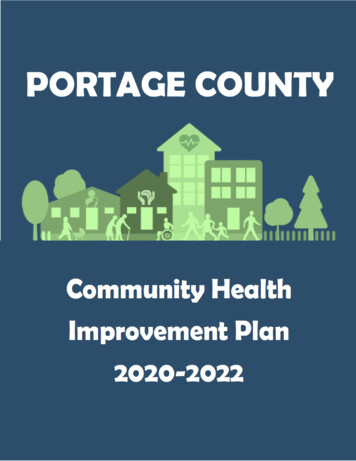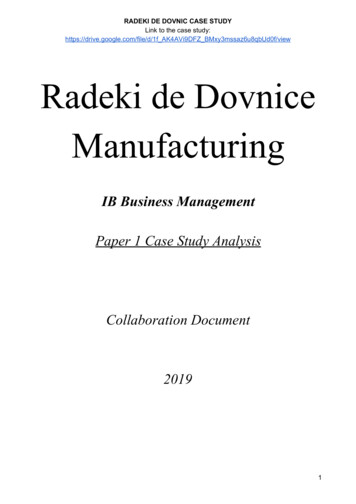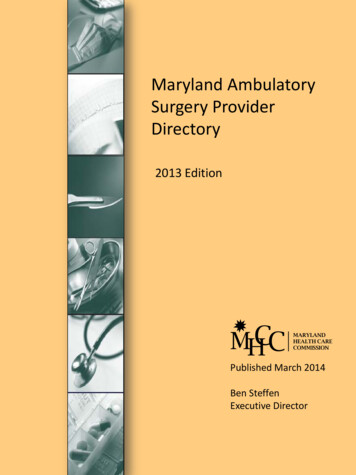
Transcription
Table of ContentsExecutive Summary .4Introduction .4Public Health Accreditation Board (PHAB) Requirements .4Mobilizing for Action through Planning & Partnerships (MAPP) Process Overview .5Inclusion of Vulnerable Populations (Health Disparities) .6Alignment with National and State Standards .6Strategies . 10Vision and Mission. 12Community Health Status Assessment . 14Key Issues . 20Priorities Chosen . 25Community Themes and Strengths Assessment (CTSA) . 26Open-ended Questions to the Committee (August 27, 2019) . 26Quality of Life Survey (August-October 2019). 28Forces of Change Assessment. 29Local Public Health System Assessment . 31Gap Analysis, Strategy Selection, Evidence-Based Practices, and Resources . 33Priority #1: Mental Health, Substance Use and Addiction. 34Priority #2: Chronic Disease . 44Priority #3: Maternal, Infant, and Child Health . 55Cross-Cutting Strategies (Strategies that Address Multiple Priorities) . 60Progress and Measuring Outcomes . 70Appendix I: Gaps and Strategies . 71Note: Throughout the report, hyperlinks will be highlighted in bold, gold text.Table of Contents 3
Executive SummaryIntroductionA community health improvement plan (CHIP) is a community-driven, long-term, systematic plan toaddress issues identified in a community health assessment (CHA). The purpose of the CHIP is todescribe how hospitals, health departments, and other community stakeholders will work to improve thehealth of the county. A CHIP is designed to set priorities, direct the use of resources, and develop andimplement projects, programs, and policies. The CHIP is more comprehensive than the roles andresponsibilities of health organizations alone, and the plan’s development must include participation of abroad set of community stakeholders and partners. This CHIP reflects the results of a collaborativeplanning process that includes significant involvement by a variety of community sectors.Portage County Community Health Partners has been conducting CHAs since 2015 to measurecommunity health status. The most recent Portage County CHA was cross-sectional in nature andincluded a written survey of adults, adolescents, and children within Portage County. The questions weremodeled after the survey instruments used by the Centers for Disease Control and Prevention (CDC) forthe national and state Behavioral Risk Factor Surveillance System (BRFSS), Youth Risk BehaviorSurveillance System (YRBSS), and National Survey of Children’s Health (NSCH). This has allowed PortageCounty to compare their CHA data to national, state and local health trends. Community stakeholderswere actively engaged in the early phases of CHA planning and helped define the content, scope, andsequence of the project.Portage County Community Health Partners contracted with the Hospital Council of Northwest Ohio(HCNO), a neutral, regional, nonprofit hospital association, to facilitate the CHA and CHIP. PortageCounty Community Health Partners then invited various community stakeholders to participate incommunity health improvement process. Data from the most recent CHA were carefully considered andcategorized into community priorities with accompanying strategies. This was done using the NationalAssociation of County and City Health Officials’ (NACCHO) national framework, Mobilizing for Actionthrough Planning and Partnerships (MAPP). Over the next three years, these priorities and strategies willbe implemented at the county-level with the hope to improve population health and create lasting,sustainable change. It is the hope of Portage County Community Health Partners that each agency in thecounty will tie their internal strategic plan to at least one strategy in the CHIP.Public Health Accreditation Board (PHAB) RequirementsNational Public Health Accreditation status through the Public Health Accreditation Board (PHAB) is themeasurement of health department performance against a set of nationally recognized, practice-focusedand evidenced-based standards. The goal of the national accreditation program is to improve andprotect the health of the public by advancing the quality and performance of Tribal, state, local, andterritorial public health departments. PHAB requires that CHIPs be completed at least every five years,however, Ohio state law (ORC 3701.981) requires that health departments and hospitals collaborate tocreate a CHIP every 3 years. Additionally, PHAB is a voluntary national accreditation program, howeverthe State of Ohio requires that all local health departments become accredited by 2020, making itimperative that all PHAB requirements are met.PHAB standards also require that a community health improvement model is utilized when planningCHIPs. This CHIP was completed using NACCHO’s MAPP process. MAPP is a national, community-drivenplanning process for improving community health. This process was facilitated by HCNO in collaborationwith various local agencies representing a variety of sectors.Executive Summary 4
Mobilizing for Action through Planning & Partnerships (MAPP) Process OverviewThis 2020-2022 CHIP was developed using the Mobilizing Action through Partnerships and Planning(MAPP) process, which is a nationally adopted framework developed by the National Association ofCounty and City Health Officials (NACCHO) (see Figure 1.1). MAPP is a community-driven planningprocess for improving community health and is flexible in its implementation, meaning that the processdoes not need to be completed in a specific order. This process was facilitated by HCNO in collaborationwith a broad range of local agencies representing a variety of sectors of the community. This processinvolved the following six phases:1. Organizing for success and partnership developmentDuring this first phase, community partners examined thestructure of its planning process to build commitment andengage partners in the development of a plan that couldbe realistically implemented. With a steering committeealready in place, members examined current membershipto determine whether additional stakeholders and/orpartners should be engaged, its meeting schedule (whichoccurs on a quarterly basis and more frequently asneeded), and responsibilities of partnering organizationsfor driving change. The steering committee ensured thatthe process involved local public health, health care,faith-based communities, schools, local leadership,businesses, organizations serving minority populations,and other stakeholders in the community healthimprovement process.Figure 1.1 The MAPP Framework2. VisioningNext, steering committee members re-examined its visionand mission. Vision and values statements provide focus,purpose, and direction to the CHA/CHIP so thatparticipants collectively achieve a shared vision for the future. A shared community vision provides anoverarching goal for the community—a statement of what the ideal future looks like. Values are thefundamental principles and beliefs that guide a community-driven planning process.3. The four assessmentsWhile each assessment yields valuable information, the value of the four MAPP assessments is multipliedconsidering results as a whole. The four assessments include: The Community Health Status Assessment(CHSA), the Local Public Health System Assessment (LPHSA), the Forces of Change (FOC) Assessment,and the Community Themes and Strengths Assessment (CTSA).4. Identifying strategic issuesThe process to formulate strategic issues occurs during the prioritization process of the CHA/CHIP. Thecommittee considers the results of the assessments, including data collected from community members(primary data) and existing statistics (secondary data) to identify key health issues. Upon identifying thekey health issues, an objective ranking process is used to prioritize health needs for the CHIP.In order to identify strategic issues, the steering community considers findings from the visioningprocess and the MAPP assessments in order to understand why certain issues remain constant across theassessments. The steering committee uses a strategic approach to prioritize issues that would have thegreatest overall impact to drive population health improvement and would be feasible, given theExecutive Summary 5
resources available in the community and/or needed, to accomplish. The steering committee alsoarranged issues that were related to one another, for example, chronic disease related conditions, whichcould be addressed through increased or improved coordination of preventative services. Finally, thesteering committee members considered the urgency of issues and the consequences of not addressingcertain items.5. Formulate goals and strategiesFollowing the prioritization process, a gap analysis is completed in which committee members identifygaps within each priority area, identify existing resources and assets, and potential strategies to addressthe priority health needs. Following this analysis, the committee to formulate various goals, objectives,and strategies to meet the prioritized health needs.6. Action cycleThe steering committee begins implementation of strategies as part of the next community healthimprovement cycle. Both progress data to track actions taken as part of the CHIP’s implementation andhealth outcome data (key population health statistics from the CHA) are continually tracked throughongoing meetings. As the end of the CHIP cycle, partners review progress to select new and/or updatedstrategic priorities based on progress and the latest health statistics.Inclusion of Vulnerable Populations (Health Disparities)According to the 2017 American Community Survey 1-year estimates, Portage County is 91% Caucasion,4% African American, 2% Hispanic/Latino, 2% Asian, and 1% American Indian and Alaska Native.Approximately 15% of Portage County residents were below the poverty line. For this reason, data wasbroken down by income. Data were carefully considered and prioritized based on needs of vulnerablepopulations living in Portage County.Alignment with National and State StandardsThe 2020-2022 Portage County CHIP priorities align with state and national priorities. Portage Countywill be addressing the following priorities: mental health, substance abuse and addiction, chronic disease,and maternal, infant and child health.Ohio State Health Improvement Plan (SHIP)Note: This symbol will be used throughout the report when a priority, indicator, or strategy directlyaligns with the 2017-2019 SHIP.SHIP OverviewThe 2017-2019 State Health Improvement Plan (SHIP) serves as a strategic menu of priorities, objectives,and evidence-based strategies to be implemented by state agencies, local health departments, hospitalsand other community partners and sectors beyond health including education, housing, employers, andregional planning.The SHIP includes a strategic set of measurable outcomes that the state will monitor on an annual basis.Given that the overall goal of the SHIP is to improve health and wellbeing, the state will track thefollowing health indicators: Self-reported health status (reduce the percent of Ohio adults who report fair or poor health)Premature death (reduce the rate of deaths before age 75)Executive Summary 6
SHIP PrioritiesIn addition to tracking progress on overall health outcomes, the SHIP will focus on three priority topics:1. Mental Health and Addiction (includes emotional wellbeing, mental illness conditions andsubstance abuse disorders)2. Chronic Disease (includes conditions such as heart disease, diabetes and asthma, and relatedclinical risk factors-obesity, hypertension and high cholesterol, as well as behaviors closelyassociated with these conditions and risk factors- nutrition, physical activity and tobacco use)3. Maternal and Infant Health (includes infant and maternal mortality, birth outcomes and relatedrisk and protective factors impacting preconception, pregnancy and infancy, including family andcommunity contexts)Cross-cutting FactorsThe SHIP also takes a comprehensive approach to improving Ohio’s greatest health priorities byidentifying cross-cutting factors that impact multiple outcomes. Rather than focus only on diseasespecific programs, the SHIP highlights powerful underlying drivers of wellbeing, such as student success,housing affordability and tobacco prevention. This approach is built upon the understanding that accessto quality health care is necessary, but not sufficient, for good health. The SHIP is designed to promptstate and local stakeholders to implement strategies that address the Social determinants of health andhealth behaviors, as well as approaches that strengthen connections between the clinical healthcaresystem, public health, community-based organizations and sectors beyond health.SHIP planners drew upon this framework to ensure that the SHIP includes outcomes and strategies thataddress the following cross-cutting factors: Health equity: Attainment of the highest level of health for all people. Achieving health equityrequires valuing everyone equally with focused and ongoing societal efforts to address avoidableinequalities, historical and contemporary injustices, and the elimination of health and healthcaredisparities.Social determinants of health: Conditions in the social, economic and physical environmentsthat affect health and quality of life.Public health system, prevention and health behaviors:o The public health system is comprised of government agencies at the federal, state, andlocal levels, as well as nongovernmental organizations, which are working to promotehealth and prevent disease and injury within entire communities or population groups.o Prevention addresses health problems before they occur, rather than after people haveshown signs of disease, injury or disability.o Health behaviors are actions that people take to keep themselves healthy (such as eatingnutritious food and being physically active) or actions people take that harm their healthor the health of others (such as smoking). These behaviors are often influenced by family,community and the broader social, economic and physical environment.Healthcare system and access: Health care refers to the system that pays for and delivers clinicalhealth care services to meet the needs of patients. Access to health care means having timely useof comprehensive, integrated and appropriate health services to achieve the best healthoutcomes.Executive Summary 7
CHIP Alignment with the 2017-2019 SHIPThe 2020-2022 Portage County CHIP is required to select at least 2 priority topics, 1 priority outcomeindicator, 1 cross cutting strategy and 1 cross-cutting outcome indicator to align with the 2017-2019SHIP. The following Portage County CHIP priority topics, outcomes and cross cutting factors very closelyalign with the 2017-2019 SHIP priorities:Figure 1.2 2020-2022 Portage CHIP Alignment with the 2017-2019 SHIP2020-2022 Portage CHIP Alignment with the 2017-2019 SHIPPriorityTopicPriority Outcome Decrease adult and youth suicide ideationDecrease adult and youth alcohol useDecrease youth marijuana useReduce adult and youth cigarette smokingChronicDisease Maternaland InfantHealth Decrease diabetesIncrease hypertension managementDecrease food insecurityIncrease adult and youth fruit consumptionIncrease adult and youth vegetableconsumptionDecrease adult, youth and child obesityIncrease youth and child physical activityDecrease preterm birthsDecrease low birth rateDecrease infant mortalityMentalhealth andaddictionCross-CuttingOutcomeCross-cutting Factor Socialdeterminants ofhealthHealthcare systemand accessHealth equity Decrease severehousing problemsDecrease povertyIncrease highschool graduationratesU.S. Department of Health and Human Services National Prevention StrategiesThe Portage County CHIP also aligns with six of the National Prevention Priorities for the U.S. population:tobacco free living, preventing drug abuse and excessive alcohol use, healthy eating, active living, injuryand violence free living, and mental and emotional well-being. For more information on the nationalprevention priorities, please go to surgeongeneral.gov.Executive Summary 8
Alignment with National and State Standards, continuedFigure 1.3 2017-2019 State Health Improvement Plan (SHIP) OverviewExecutive Summary 9
StrategiesTo work toward improving mental health, substance use and addiction outcomes the followingaction steps are recommended:Mental Health Strategies1.2.3.4.5.6.Assess, develop, and provide mental health resources to youth and adults in Portage CountyScreening for Adverse Childhood Experiences (ACEs) using a standardized toolScreening for suicide for patients 12 or older using a standardized toolYouth alcohol/other drug prevention and mental health programsCommunity-based comprehensive plan to reduce alcohol and drug abuseIncrease awareness and accessibility of treatment options for those with substance use disorderSubstance Use and Addiction Strategies7.8.9.10.Safe Communities campaignTobacco-free policiesLinks to cessation supportData sharingTo work toward improving chronic disease outcomes, the following actions steps are recommended:1.2.3.4.5.6.7.8.9.10.Food insecurity screening and referralNutrition prescriptionsHealthy eating practices through fostering self-efficacyPrediabetes screening and referralHypertension screening and follow upIncrease awareness of nutrition/physical activity resourcesPrescriptions for healthCommunity gardensShared use (joint use agreements)Community fitness programsTo work toward improving maternal, child and infant health outcomes, the following actions stepsare recommended:1.2.3.4.Reproductive health interventionsHome visiting programs that begin prenatallyIncrease enrollment of WIC programProvide referrals/resources to all patients on health insurance access to ensure reproductive healthcare5. Create and implement a Safe Kids Coalition planExecutive Summary 10
To develop cross-cutting strategies that address multiple priorities, the following action steps arerecommended:Social Determinants of Health1.2.3.4.5.Home improvement loans and grantsService-enriched housingOutreach to increase uptake for earned income tax creditsFinancial literacyIncrease transportation through a county transportation planHealthcare System and Access1.2.3.4.School-based health centersHealth transportation outreachHealth insurance enrollment and outreachExpand SOAR Student-Run Free ClinicHealth Equity1.Implicit bias trainingExecutive Summary 11
Vision and MissionVision statements define a mental picture of what a community wants to achieve over time while themission statement identifies why an organization/coalition exists and outlines what it does, who it does itfor, and how it does what it does.The Vision of Portage County:Creating and sustaining a healthy Portage County through collaboration, prevention, and wellness.The Mission of Portage County:Mobilizing partnerships to improve and sustain Portage County health, wellness, and quality of life.Community PartnersThe CHIP was planned by various agencies and service-providers within Portage County. From August2019 to October 2019, Portage County Community Health Partners reviewed many data sourcesconcerning the health and social challenges that Portage County residents are facing. They determinedpriority issues which, if addressed, could improve future outcomes; determined gaps in currentprogramming and policies; examined best practices and solutions; and determined specific strategies toaddress identified priority issues. We would like to recognize these individuals and thank them for theirdedication to this process:Portage County Community Health Partners AxessPointe Community Health CenterChildren’s AdvantageColeman Professional ServicesFamily and Children First CouncilHiram CollegeKent City Health DepartmentKent State University College of NursingKent State University College of Public Health &Center for Public Policy and HealthKent State University Health ServicesMental Health & Recovery Board of PortageCountyNortheast Ohio Medical University (NEOMED)OhioCANPARTAPortage County Board of HealthPortage County Children’s Services Portage County Combined General HealthDistrictPortage County Job & Family ServicesPortage County Safe Communities CoalitionPortage County School DistrictsPortage County Township TrusteesPortage County TreasurerPortage County WICPortage Fatherhood InitiativePortage Park DistrictPortage Substance Abuse Community CoalitionSequoia WellnessSuicide Prevention Coalition of Portage CountyThe Portage FoundationTownhall IIUniversity Hospitals Portage Medical CenterUnited Way of Portage CountyThe community health improvement process was facilitated by Emily Golias, Community HealthImprovement Coordinator, from Hospital Council of Northwest Ohio.Executive Summary 12
Community Health Improvement ProcessBeginning in August 2019, the Portage County Community Health Partners met four (4) times andcompleted the following planning steps:1.Initial Meeting Review the process and timeline Finalize committee members Create or review vision2. Choose Priorities Use of quantitative and qualitative data to prioritize target impact areas3. Rank Priorities Rank health problems based on magnitude, seriousness of consequences, and feasibilityof correcting4. Community Themes and Strengths Assessment Open-ended questions for committee on community themes and strengths5. Forces of Change Assessment Open-ended questions for committee on forces of change6. Local Public Health Assessment Review the Local Public Health System Assessment with committee7. Gap Analysis Determine discrepancies between community needs and viable community resources toaddress local priorities Identify possible strategies8. Quality of Life Survey Review results of the Quality of Life Survey with committee9. Strategic Action Identification Identification of evidence-based strategies to address health priorities10. Best Practices Review of best practices, proven strategies, evidence continuum, and feasibility continuum11. Resource Assessment Determine existing programs, services, and activities in the community that addressspecific strategies12. Draft Plan Review of all steps taken Action step recommendations based on one or more of the following: enhancing existingefforts, implementing new programs or services, building infrastructure, implementingevidence-based practices, and feasibility of implementationExecutive Summary 13
Community Health Status AssessmentPhase 3 of the MAPP process, the Community Health Status Assessment, or CHA, is a 240-page report thatincludes primary data with over 100 indicators and hundreds of data points related health and well-being,including social determinants of health. Over 50 sources of secondary data are also included throughoutthe report. The CHA serves as the baseline data in determining key issues that lead to priority selection. Thefull report can be found at ssessments/.Below is a summary of county primary data and the respective state and national benchmarks.Portage County Adult Trend .S.2017Rated general health as good, very good, or excellentRated general health as excellent or very good83%53%88%47%81%49%83%51%Rated general health as fair or poorRated mental health as not good on four or more days (in the past 30 days)Rated physical health as not good on four or more days (in the past 30 days)Average number of days that physical health was not good (in the past 30 *3.7*Average number of days that mental health was not good (in the past 30 days)Poor physical or mental health kept them from doing usual activities, such asself-care, work, or recreation (on at least one day during the past 30 days)Healthcare Coverage, Access, and UtilizationUninsuredHad one or more persons they thought of as their personal health careproviderVisited a doctor for a routine checkup (in the past 12 months)Visited a doctor for a routine checkup (5 or more years ago)Arthritis, Asthma, & DiabetesEver been told by a doctor they have diabetes (not pregnancyrelated)Ever diagnosed with some form of arthritis, rheumatoid arthritis, gout, lupus, orfibromyalgiaHad ever been told they have asthmaCardiovascular %15%14%14%Ever diagnosed with angina or coronary heart disease9%6%5%4%Ever diagnosed with a heart attack, or myocardial infarctionEver diagnosed with a %Adult VariablesHealth StatusHad been told they had high blood pressureHad been told their blood cholesterol was highHad their blood cholesterol checked within the last five yearsCancerDiagnosed with skin cancerDiagnosed with any type of cancer (other than skin cancer)Weight StatusOverweight (BMI of 25.0 – 29.9)Obese (includes severely and morbidly obese, BMI of 30.0 and above)N/A – Not AvailableIndicates alignment with the Ohio State Health Assessment*2016 BRFSS as compiled by 2019 County Health Rankings**Includes skin cancer. Please compare with caution.Community Health Status Assessment 14
Current drinker (had at least one drink of alcohol within the past 30 days)Binge drinker (males having five or more drinks on one occasion, females havingfour or more drinks on one occasion)Tobacco Use62%78%54%55%22%27%19%17%Current smoker (smoked on some or all days)13%16%21%17%Former smoker (smoked 100 cigarettes in lifetime and now do not smoke)23%27%24%25%Tried to quit smoking (on at least one day in the past year)52%66%N/AN/ACurrent e-cigarette user (vaped on some or all days)N/A4%5%5%Used marijuana or hashish (in the past 6 months)Used drugs not prescribed for them or took more than prescribed to feel good,high, and/or more active or alert (in the past 6 months)Preventive Medicine10%8%*N/AN/A10%6%*N/AN/AHad a flu shot in the past year (age 65 and older)88%72%63%60%Had a pneumonia vaccine (age 65 and older)Had a clinical breast exam in the past two years(age 40 and older)Had a mammogram in the past two years(age 40 and older)Had a Pap test in the past three years (ages 82%*80%*56%62%39%*40%*21%23%21%*21%*Felt sad or hopeless for two or more weeks in the past year15%17%N/AN/ASeriously considered attempting suicide in the past year6%6%N/AN/AAttempted suicide in the past year5%5%N/AN/A64%71%68%*66%*9%10%11%*10%*Adult VariablesAlcohol ConsumptionDrug UseHad a PSA test in within the past year (age 40 and over)Quality of LifeLimited in some way because of physical, mental or emotional problemMental HealthOral HealthVisited a dentist or a dental clinic (within the past year)Visited a dentist or a dental clinic (5 or more years ago)N/A – Not AvailableIndicates alignment with the Ohio State Health Assessment*2016 BRFSS as compiled by 2019 County Health Rankings**Includes skin cancer. Please compare with caution.Community Health Status Assessment 15
Portage County Youth Trend 9(6th-12th)PortageCounty2019(9th-12th)U.S.20
Executive Summary 5 Mobilizing for Action through Planning & Partnerships (MAPP) Process Overview This 2020-2022 CHIP was developed using the Mobilizing Action through Partnerships and Planning (MAPP) process, which is a nationally adopted framework developed by the National Association of County and City Health Officials (NACCHO) (see Figure 1.1).











